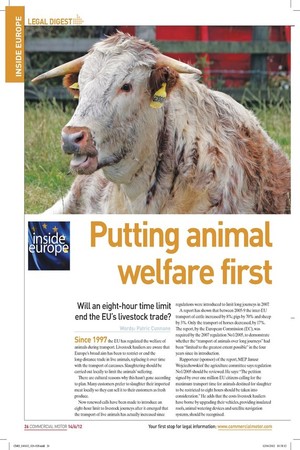Putting animal welfare first
Page 18

Page 19

If you've noticed an error in this article please click here to report it so we can fix it.
Will an eight-hour time limit end the EU’s livestock trade?
Words: Patric Cunnane Since 1997 the EU has regulated the welfare of animals during transport. Livestock hauliers are aware that Europe’s broad aim has been to restrict or end the long-distance trade in live animals, replacing it over time with the transport of carcasses. Slaughtering should be carried out locally to limit the animals’ suffering.
There are cultural reasons why this hasn’t gone according to plan. Many customers prefer to slaughter their imported meat locally so they can sell it to their customers as fresh produce.
Now renewed calls have been made to introduce an eight-hour limit to livestock journeys after it emerged that the transport of live animals has actually increased since regulations were introduced to limit long journeys in 2007.
A report has shown that between 2005-9 the inter-EU transport of cattle increased by 8%; pigs by 70% and sheep by 3%. Only the transport of horses decreased, by 17%. The report, by the European Commission (EC), was required by the 2007 regulation No1/2005, to demonstrate whether the “transport of animals over long journeys” had been “limited to the greatest extent possible” in the four years since its introduction.
Rapporteur (sponsor) of the report, MEP Janusz Wojciechowskiof the agriculture committee says regulation No1/2005 should be reviewed. He says: “The petition signed by over one million EU citizens calling for the maximum transport time for animals destined for slaughter to be restricted to eight hours should be taken into consideration.” He adds that the costs livestock hauliers have borne by upgrading their vehicles, providing insulated roofs, animal watering devices and satellite navigation systems, should be recognised. “These costs have not been reflected in the rates for live animal transport and should also be borne by other entities involved in production,” he says.
Spanish MEP Luis de Grandes Pascual, leading on the report for the transport committee, does not believe an eight-hour limit is practical for periphery member states, including his own. “You cannot even cross Spain in eight hours,” says a spokeswoman for the MEP. However, the transport committee’s opinion repeats the call for the establishment of a ‘maximum eight-hour journey limit for animals transported for the purpose of being slaughtered’ .
Gold-plating regulations
The proposals are at an early stage in the parliamentary process, but the failure of the 2007 regulation means there is a chance that supporters of the eight-hour limit will prevail. The regulation may be gold-plated by adding specified break/watering periods for the animals. Some countries would find it so difficult to comply that they would be forced to abandon the trade in live animals. ■










































